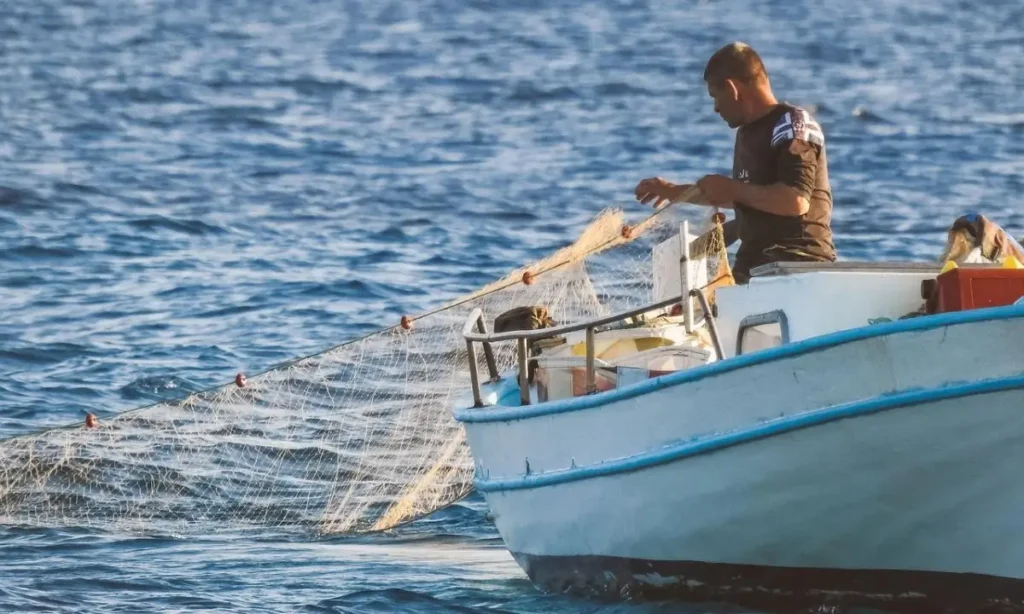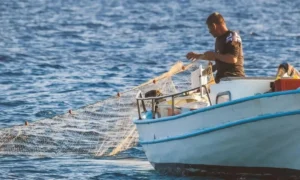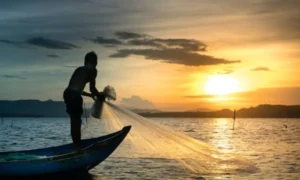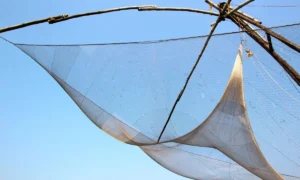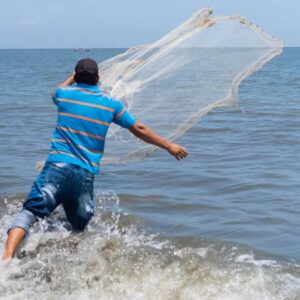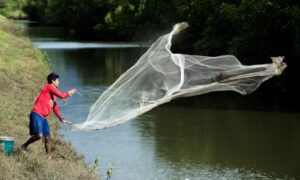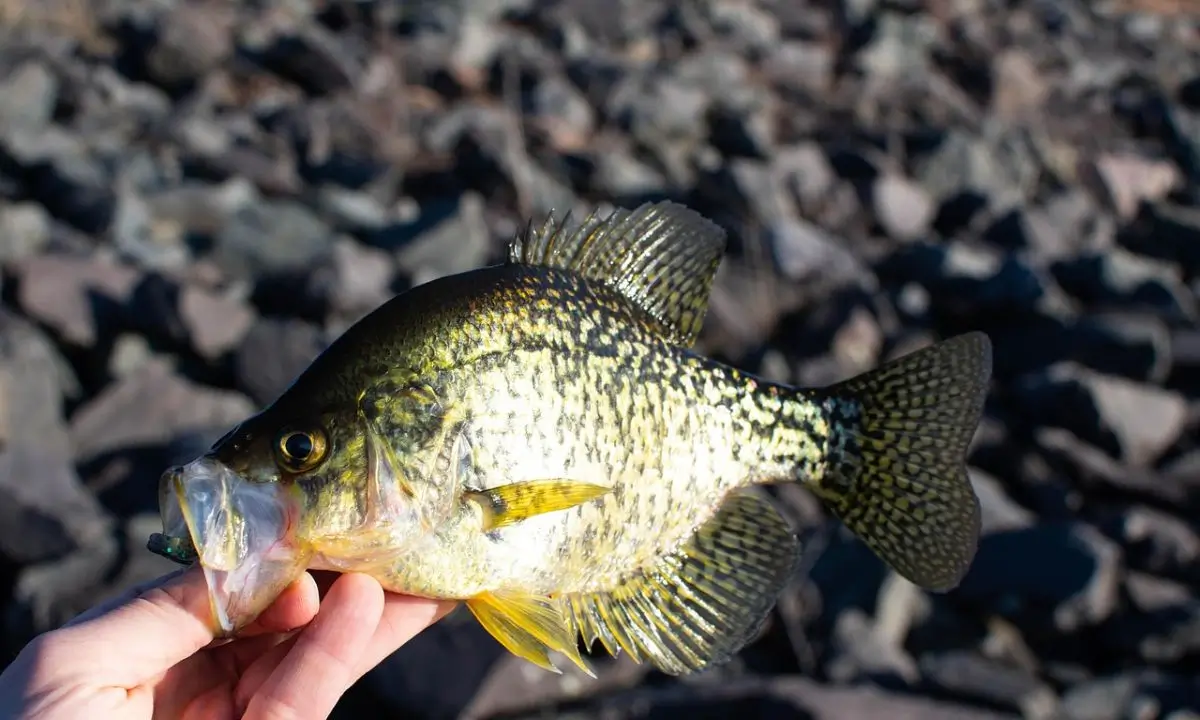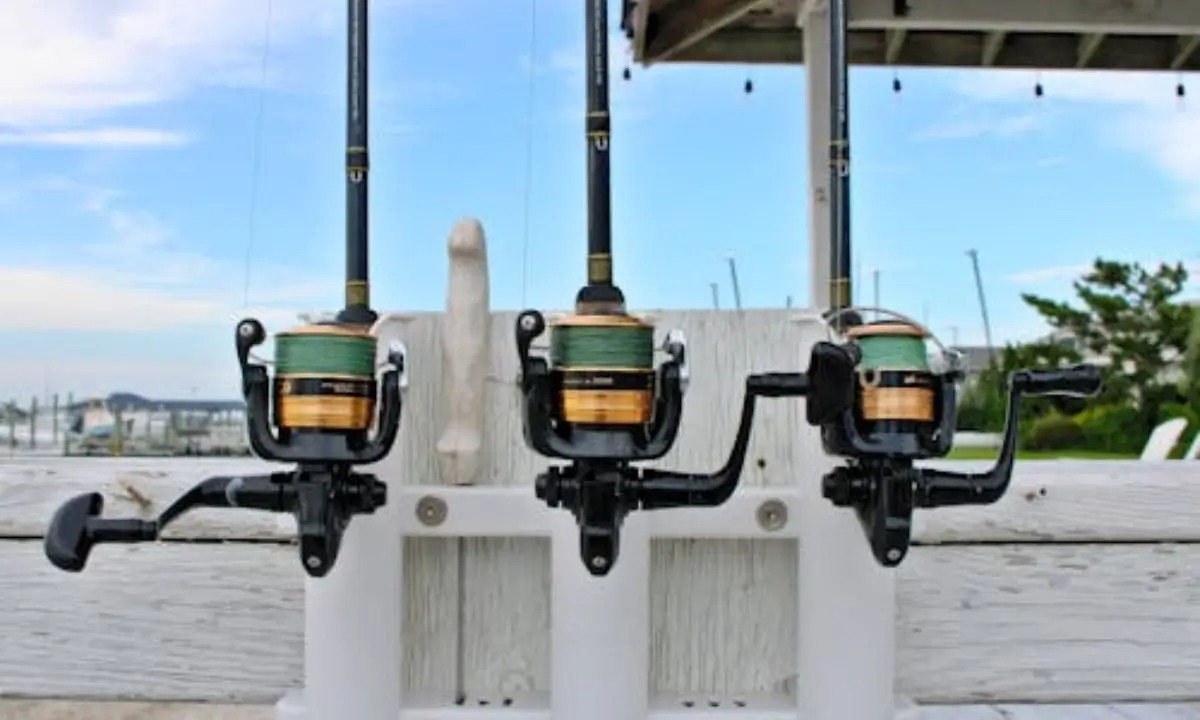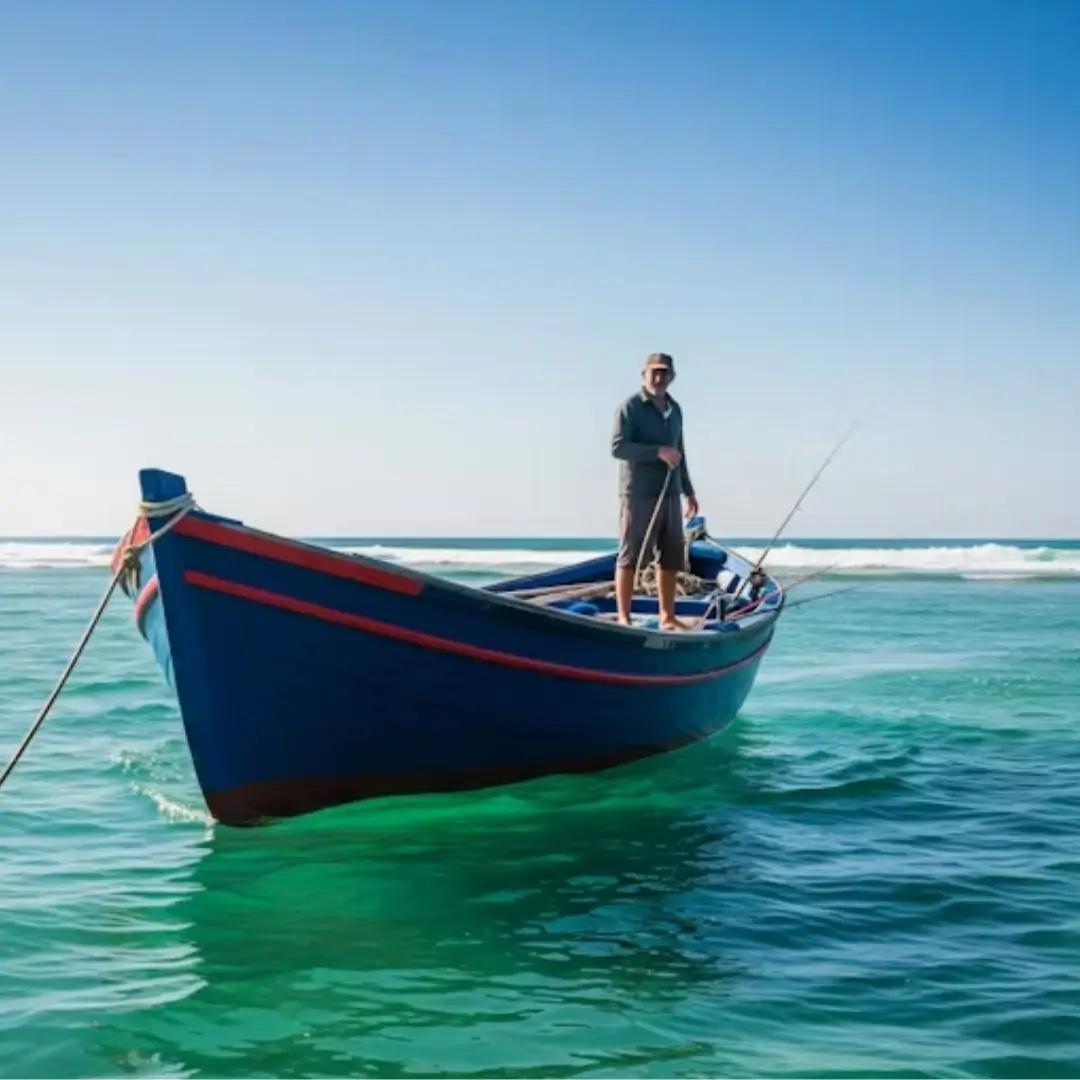Introduction:
Starting your fishing journey? The best fishing net for beginners is a lightweight, durable, and easy-to-handle landing net that works well in ponds, rivers, or from a kayak.
If you’re starting your fishing journey, choosing the right net can make the difference between a successful catch and a frustrating day. A good beginner fishing net should have a strong handle, knotless or rubber mesh to protect fish, and a size that matches your fishing style. As a fisherman with over 5 years of experience, I’ve seen how the right net builds confidence for new anglers. In this guide, we’ll explore different net types, materials, and tips to help you select the best fishing net for beginners so your first fishing trips are smooth, safe, and enjoyable.
What is a Fishing Net?
A fishing net is one of the oldest and most effective tools used to catch fish. It is made of mesh material, usually nylon or rubber, that allows water to pass through while holding the fish inside. Fishing nets come in different shapes and sizes, but the main purpose is always the same—helping anglers land fish quickly and safely.
For beginners, a fishing net works like an extra helping hand. Instead of struggling to pull a fish by the line, the net makes landing easier and reduces the chance of losing your catch. Modern nets are designed with knotless or rubber-coated mesh, which protects the fish’s scales and makes them safe for catch-and-release fishing. Whether you are fishing from a boat, shore, or kayak, a good net ensures you handle fish with care while making your fishing trip more enjoyable.
Why Beginners Need the Right Fishing Net
For someone just starting out, the right fishing net can make fishing much easier and more enjoyable. Beginners often face common problems—like losing fish at the last moment, struggling to control the line, or harming the fish while trying to bring it in. A proper fishing net solves all of these issues by giving anglers a safe and simple way to land their catch.
A beginner-friendly net is usually lightweight, so it doesn’t feel heavy during use. It also comes with a strong but comfortable handle that allows better control. The mesh plays a big role too: knotless or rubber-coated nets protect the fish’s body, making them safe for catch-and-release fishing. Without the right net, beginners may end up damaging the fish, breaking their line, or even losing their catch completely.
Choosing the right fishing net also builds confidence. When new anglers land their first fish smoothly, it motivates them to keep learning and enjoying the sport. That’s why investing in the best fishing net for beginners is more than just buying gear—it’s about making the first fishing experiences positive, safe, and rewarding.
Types of Fishing Nets
When looking for the best fishing net for beginners, it helps to know the main types of nets available. Each net is designed for a different style of fishing, and understanding their uses will make choosing much easier.
- Landing Net
A landing net is the most common choice for beginners. It has a long or short handle with a mesh basket, making it perfect for safely bringing in fish from a boat, shore, or kayak. It’s lightweight, easy to use, and ideal for most freshwater species. - Cast Net
A cast net is thrown by hand and spreads out in a circle before sinking. This type is usually used to catch small baitfish rather than big game fish. While fun to learn, it may take beginners some practice. - Dip Net
A dip net has a long handle and is pushed into the water to scoop fish. It’s often used in shallow waters or for catching small fish near the surface. Simple and beginner-friendly. - Gill Net
A gill net traps fish by their gills as they swim through. However, it’s not recommended as the best fishing net for beginners, since it can harm fish and is often restricted by fishing laws.
Choosing between these nets depends on your fishing style, but for new anglers, the landing net remains the safest and most effective starting point. details Pontoon Boat
Maintenance Tips: Keeping Your Fishing Net in Top Condition
Taking care of your fishing net is just as important as choosing the best fishing net for beginners. A well-maintained net lasts longer, works better, and saves you from spending money on early replacements. Here are some simple tips to keep your net in top condition:
- Rinse After Every Trip
Always rinse your net with fresh water after fishing, especially if you’ve been in saltwater. Salt and dirt can weaken the mesh over time. - Dry Properly Before Storing
Never store a wet net. Hang it in a shaded area to dry completely. This prevents mold, bad odor, and damage to the material. - Avoid Direct Sunlight
Prolonged exposure to sunlight can weaken nylon or rubber-coated nets. Store your net in a cool, dry place when not in use. - Check for Damage
Inspect your net regularly for small holes or tears. Repair them quickly so fish don’t escape during your next trip. - Store Correctly
Don’t throw your net in a corner. Use a hook or hanger to keep the frame straight and the mesh untangled.
By following these easy maintenance steps, your fishing net will stay reliable for many seasons and make every trip enjoyable.
Top 5 Best Fishing Nets for Beginners in 2025
Not all nets are created equal. Let’s go over the most common types, with beginner-friendliness in mind:
Landing Nets
These are hand-held nets used to scoop a fish close to the boat, bank, or dock.
Beginner-Friendly? ✅ Yes – Light, easy to use, and versatile.
Casting Nets
Circular nets you throw into the water to trap fish. It takes some technique to master.
Beginner-Friendly? ❌ Not really – Better for experienced anglers.
Dip Nets
Small nets for catching baitfish or scooping fish from a Lovewell.
Beginner-Friendly? ✅ Yes – Simple and useful for bait handling.
Seine Nets
Large nets that require two people to drag across shallow water.
Beginner-Friendly? ❌ No – Needs coordination and space.
Hoop Nets
These nets are cylindrical and designed to trap fish when they swim inside. Great for passive fishing.
Beginner-Friendly? ✅ Yes – Just set it and check later, no advanced skill needed
Lift Nets
A net submerged in the water and lifted to catch fish that swim above it. Mostly used from piers or docks.
Beginner-Friendly? ✅ Yes – Simple mechanism, easy to handle from a fixed spot.
Best Materials for Fishing Nets
When choosing the best fishing net for beginners, the material of the mesh is just as important as the size or handle. The right material makes the net easier to use, safer for the fish, and more durable for long-term fishing. Here are the most common options:
-
Nylon Mesh
Nylon is the most traditional choice. It’s lightweight, affordable, and dries quickly. However, it can sometimes cause damage to fish scales, so it’s less ideal if you plan to practice catch-and-release fishing. -
Rubber-Coated Mesh
A rubber fishing net is very beginner-friendly. The rubber coating prevents hooks from getting tangled, protects the fish, and is easy to clean. Many anglers consider this the top choice for beginners who want both convenience and fish safety. -
Knotless Mesh
A knotless net is designed without rough knots that can harm fish. It’s smooth, safe, and perfect for beginners who want to release fish back into the water without injuries. -
Traditional Cotton or Rope Nets
These are less common today but still used in some areas. They are heavier, harder to maintain, and not recommended as the best fishing net for beginners.
Key Features to Look for in a Beginner Fishing Net
Choosing your first net isn’t just about picking something cheap or fancy. There are the key things to looks for:
Net Material
Rubber: Soft, doesn’t damage fish, easy to clean.
Nylon: Lightweight, but can harm delicate fish scales.
Knotless: Ideal for catch-and-release fishing.
Recommended Fishing Nets for Beginners
Finding the best fishing net for beginners can feel overwhelming because there are many types, sizes, and materials to choose from. Here’s a list of top beginner-friendly nets that balance usability, safety, and durability.
-
Lightweight Landing Net
A small to medium landing net is perfect for beginners. Its lightweight frame makes it easy to handle, and the rubber-coated mesh protects fish scales. Ideal for freshwater fishing from shore, boat, or kayak. -
Foldable or Telescopic Net
These nets are compact and easy to carry, making them ideal for anglers who travel or kayak fish. The extendable handle lets beginners reach fish in deeper water without straining. -
Rubber-Coated Kayak Fishing Net
Specifically designed for kayak fishing, this net is light, durable, and prevents hooks from tangling. Its compact size fits neatly in kayak storage while still being strong enough for most fish species. -
Knotless Mesh Net
A knotless fishing net ensures fish are not injured, which is perfect for catch-and-release. Its smooth mesh reduces the chance of the line or hooks getting tangled—great for beginners learning proper fish handling. -
Medium-Sized Shore or Boat Net
A simple, medium-sized net works for beginners fishing from shore or boat. Look for a strong handle and deep mesh for safe landing of small to medium fish. -
Multipurpose Net (Optional)
Some nets are designed to work both in freshwater and saltwater. If you plan to fish in different locations, choose a lightweight, corrosion-resistant net that performs well in multiple environments.
✅ Tip: Beginners should focus on rubber-coated or knotless landing nets for safety, ease of use, and durability. These nets build confidence, make landing fish easier, and provide a smooth introduction to fishing.
Handle Type & Length
- Short Handles: Great for boat or kayak fishing.
- Long Handles: Best when fishing from a pier, riverbank, or rocky area.
Foldability and Portability
Look for nets that fold or telescope. They’re easier to carry, especially if you hike to your fishing spots.
Size of the Hoop/Net
Medium-sized hoops are best for beginners—big enough for most catches, but easy to manage.
Fishing Environment
- Pond: Small, basic net will do.
- River: Go for a strong, long-handled net.
- Kayak: Foldable nets are a must.
- Saltwater: Rust-resistant metal parts are essential.
-
-
How to Choose the Right Fishing Net
Choosing the best fishing net for beginners can seem tricky, but focusing on a few key factors makes it easier. Here’s what to consider before buying your first net:
-
Fishing Style
Think about where you’ll fish most—shore, boat, or kayak. For kayak fishing, a compact rubber-coated net is best. For shore or boat fishing, a landing net with a medium handle works well. -
Target Fish Size
The size of your net should match the fish you expect to catch. Small freshwater fish need a small to medium net, while larger species require a deeper, sturdier mesh. Using the right size prevents fish from escaping and keeps your line safe. -
Mesh Material
Rubber-coated or knotless mesh nets are ideal for beginners. They protect fish scales, reduce tangling, and are easy to clean. Avoid traditional nylon nets if you plan catch-and-release fishing. -
Handle Length & Grip
A comfortable, strong handle is crucial. Beginners should avoid nets that are too heavy or have short handles, as these can make landing fish frustrating. Telescopic or foldable handles offer extra convenience. -
Portability & Storage
Compact, lightweight nets are easier to carry and store. If you travel or kayak fish, look for nets that fold or collapse without compromising strength.
By considering these factors, beginners can confidently select the best fishing net for beginners, ensuring safer handling, easier landings, and a more enjoyable first fishing experience.
-
How to Use a Fishing Net: Step-by-Step Guide for Beginners
From my years on the water, these are the types of nets I always recommend to newbies:
1. A Small Rubber Landing Net with Telescopic Handle
Ideal for shore or small boat fishing.
- Pros: Lightweight, extendable, gentle on fish.
- Cons: May struggle with very large fish.
2. A Foldable Nylon Net with Aluminum Frame for Kayak Users
Perfect for those with limited space.
- Pros: Compact, strong frame, good reach.
- Cons: Nylon can tangle or damage fish.
3. A Medium Hoop Rubber Net for All-Around Use
Great if you fish in multiple environments.
- Pros: Durable, versatile, low maintenance.
- Cons: Bulkier than foldable options.
Maintenance Tips: Keeping Your Fishing Net in Top Condition
-
Your fishing net can last for years if you take proper care of it. Always rinse it with fresh water after each trip, especially if you’ve been fishing in saltwater. Store it in a dry, shaded place to prevent mold and sun damage. Check regularly for tears or broken mesh and repair them early to avoid bigger issues. A clean, well-kept net performs better and saves you money in the long run. more info known Bass Fishing
-
How to Choose the Right Fishing Net
-
Choosing the best fishing net for beginners can seem tricky, but focusing on a few key factors makes it easier. Here’s what to consider before buying your first net:
-
Fishing Style
Think about where you’ll fish most—shore, boat, or kayak. For kayak fishing, a compact rubber-coated net is best. For shore or boat fishing, a landing net with a medium handle works well. -
Target Fish Size
The size of your net should match the fish you expect to catch. Small freshwater fish need a small to medium net, while larger species require a deeper, sturdier mesh. Using the right size prevents fish from escaping and keeps your line safe. -
Mesh Material
Rubber-coated or knotless mesh nets are ideal for beginners. They protect fish scales, reduce tangling, and are easy to clean. Avoid traditional nylon nets if you plan catch-and-release fishing. -
Handle Length & Grip
A comfortable, strong handle is crucial. Beginners should avoid nets that are too heavy or have short handles, as these can make landing fish frustrating. Telescopic or foldable handles offer extra convenience. -
Portability & Storage
Compact, lightweight nets are easier to carry and store. If you travel or kayak fish, look for nets that fold or collapse without compromising strength.
By considering these factors, beginners can confidently select the best fishing net for beginners, ensuring safer handling, easier landings, and a more enjoyable first fishing experience.
-
-
Real-Life Example: What I Used When I Started Fishing
When I first started out, I bought a cheap nylon net from a local shop. It looked fine—but within two weeks, the plastic handle cracked during a river trip. I ended up losing a beautiful bass because I couldn’t scoop it in time.
That day taught me a valuable lesson.
After that, I switched to a medium-sized rubber net with an aluminum telescopic handle. That net didn’t just last longer—it actually helped me land fish faster and more safely. Even now, when I guide beginners, I carry that same type of net.
The right net gave me confidence and made fishing more enjoyable. Trust me—it’s worth investing in the right gear from the beginning. -
Common Mistakes Beginners Make with Fishing Nets and How to Avoid Them
- Many beginners unknowingly make simple mistakes that affect their fishing experience. These include using the wrong type of net for the fishing environment, not cleaning the net after use, or storing it wet—leading to rot or odor. Some also forget to check for tangles before heading out. To avoid these problems, choose the right net for your needs, follow basic cleaning routines, and always inspect your gear before use.
-
How to Choose Your First Fishing Net – 5 Simple Steps
-
1. Identify Your Environment
Are you fishing in a pond, river, kayak, or saltwater coast? Your net should match where you fish most.
2. Decide on the Type
Start with a landing net. It’s the most versatile and beginner-friendly.
3. Pick the Right Material
Rubber or knotless is best for beginners—gentle on fish and easy to clean.
4. Think About Portability
If you’re always on the move, foldable or telescopic models are a smart choice.
5. Get Advice from Real Anglers
Join local fishing groups or forums. Ask questions. You’ll get honest advice from people who’ve been there.
Conclusion
Starting your fishing journey is exciting, and the right gear can make all the difference. A durable, easy-to-use, and beginner-friendly net helps you land fish confidently, reduces frustration, and makes every trip more enjoyable.
Remember, expensive doesn’t always mean better. Sometimes a simple rubber-coated or knotless net can outperform high-end options if chosen wisely—especially when you’re looking for the best fishing net for beginners.
Focus on nets that are lightweight, safe for fish, and suited to your fishing style—whether you’re fishing from a shore, boat, or kayak.
Still unsure which net to pick? Leave a comment below! I’m happy to share honest advice from over five years of fishing experience.
Have you tried using a fishing net on your fishing trips? Share your experience in the comments below and join the conversation!
-
Tight lines, safe handling, and happy fishing! 🎣
✍️ Written by Jihad – Professional Fisherman
Website: profishingbyjihad.com
-
Why should beginners use a fishing net?
Using a fishing net makes landing fish much easier and safer. It helps prevent the fish from breaking off at the last moment, reduces stress on your fishing rod, and keeps both you and the fish safe. For beginners, a net increases the success rate and makes catch-and-release more effective.
Which material is best for a beginner’s fishing net?
Rubber-coated nets are the best choice for beginners. They are gentle on fish, prevent tangling with hooks, and are easy to clean. Nylon nets are cheaper but can damage a fish’s protective slime layer. If you plan to practice catch-and-release, always go for a rubber or rubber-coated net.
What size and mesh should I choose for my fishing net?
The right mesh size depends on the type of fish you’re targeting. Small mesh (¼–½ inch) is best for panfish and trout, while medium to large mesh (1–1.5 inch) is better for bass, catfish, or larger species. Beginners should choose a versatile medium mesh to handle a variety of catches.
Should I get a foldable or telescoping fishing net?
Yes, foldable or telescoping nets are very practical for beginners. They are lightweight, easy to carry, and save space, especially if you fish from a kayak, pontoon, or shore. A fixed long-handle net works well for boats, but collapsible designs are more beginner-friendly.
Do I really need a net for catch and release?
A net is very useful for catch-and-release fishing. Rubber-coated nets protect the fish’s scales and slime coat, reducing injury. By keeping the fish in water while unhooking, you increase survival chances. Beginners often struggle with handling fish by hand, so a good net makes the process smoother and more ethical.
What handle length should I choose as a beginner?
Handle length depends on where you fish. A short handle (12–24 inches) is perfect for shore fishing or small boats. For kayak anglers, a medium telescoping handle works best. If you’re fishing from a larger boat, choose a long handle (36–48 inches) to reach fish easily.
How do I maintain my fishing net for longer use?
Always rinse your net with fresh water after fishing, especially if you fish in saltwater. Let it dry completely before storing to prevent mold and odor. Avoid leaving it in direct sunlight for long periods, as UV rays can weaken the material. With proper care, a quality net can last for many years.


